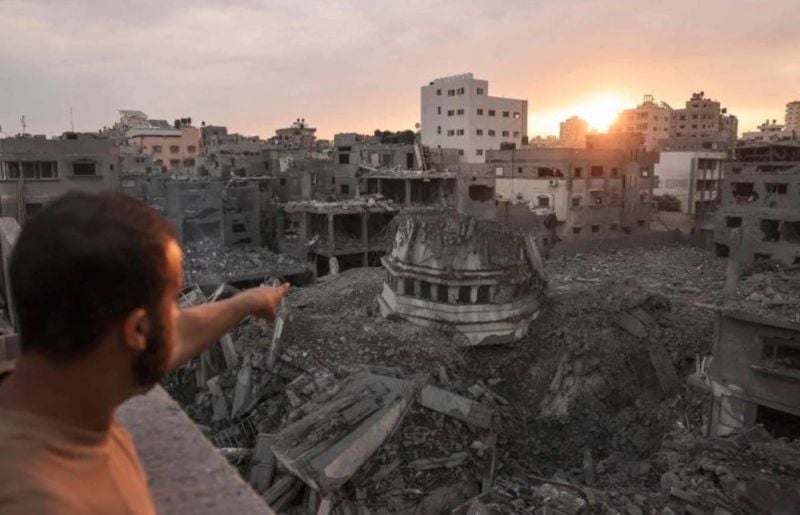
A man points to the Ahmad Yassine mosque, which was destroyed by an Israeli raid on October 9, 2023. (Credit: AFP)
Forty-one kilometers long and approximately ten kilometers wide, the Gaza Strip is a 365 km² land on which some 2.3 million Palestinians live, locked between the Mediterranean, Egypt and Israel. Since June 2007, after Hamas’ electoral victory in 2006, the Palestinians residing there have been the target of an Israeli-Egyptian land, air, and sea blockade.
On Monday, said blockade turned into a complete siege after the Israeli government cut Gaza off from water, electricity and basic necessities. Israel’s siege on Gaza is “prohibited” by international law, the UN High Commissioner for Human Rights stated Tuesday. The siege comes in response to Hamas’ military offensive on Israeli territory last Saturday. “We fight animals and act accordingly,” explained Yoav Gallant, Israeli Defense Minister on Monday.
The Gaza Strip has a young population, with a median age of 18 and over a million minors. Almost half of the population is unemployed: some 80 percent of Gaza's population lives below the poverty line and 63 percent is dependent on humanitarian aid. Over 95 percent do not have access to clean water, according to the United Nations Relief and Works Agency for Palestinian Refugees ( UNRWA ). Since last July and until the siege, Gaza had access to electricity 11 hours a day. Inside the Gaza Strip, there are eight Palestinian refugee camps. The enclave is one of the most densely populated areas in the world.
'Apartheid'
Gaza experienced successive Egyptian and Israeli occupation since the 1948 Arab-Israeli War. Israel finally withdrew from Gaza in 2005 and dismantled the eight Israeli settlements it had established there. Afterward, the Palestinian Authority, which administered the Gaza Strip after the Oslo Accords in 1993, ultimately lost its influence to Hamas, which won a landslide victory in the 2006 Palestinian legislative elections.
After a fratricidal struggle with the nationalist political party Fatah, Hamas effectively took power in 2007, which resulted in the imposition of a blockade on Gaza by the Israelis and Egyptians. Often described as an “open-air prison,” the Gaza Strip is perceived as a symbol of the Palestinian cause. For 16 years, no one has been permitted to leave without special authorization from Israel. Authorization permits can include work permits, health certificates, and other exit permits distributed on a case-by-case basis.
Since 2007, not a year has gone by without Gaza experiencing clashes of some sort. In 2021, Human Rights Watch (HRW) equated Israel's policy towards Palestinians in Gaza and the West Bank as “apartheid.” In 2022, Amnesty International declared the same.